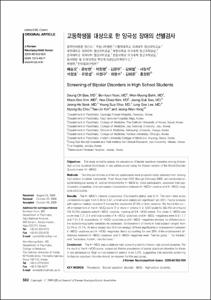고등학생을 대상으로 한 양극성 장애의 선별검사
- Affiliated Author(s)
- 김희철
- Alternative Author(s)
- Kim, Hee Cheol
- Journal Title
- 신경정신의학
- ISSN
- 1015-4817
- Issued Date
- 2009
- Abstract
- Objectives: This study aimed to
assess the prevalence of bipolar spectrum disorders among Korean high school students (individuals in late adolescence) using the Korean version of the Mood Disorder Questionnaire (K-MDQ). Methods: Two thousand male and female participants were proportionately selected from among high school students nationwide. From November 2007 through February 2008, we conducted an epidemiological survey of, and administered the K-MDQ to, these participants, assessed their psychometric properties, and compared characteristics between K-MDQ-positive and K-MDQ-negative participants. Results: The K-MDQ’s internal consistency (Cronbach’s alpha) was 0.74. The item-total score correlations ranged from 0.35 to 0.57, and all were statistically significant (p<.001). Factor analysis with varimax rotation revealed 3 factors that explained 42.6% of total variance. We found the cutoff endorsement of the K-MDQ score (7 or more in criteria 1) in 1207 students (60.4%) and found 104 (5.2%) subjects were K-MDQ-positive, meeting all 3 K-MDQ criteria. The mean K-MDQ total score was 7.2±2.9 and total scores of K-MDQ-positives and K-MDQ-negatives were 9.9±1.7 and 7.0±2.9, respectively. K-MDQ-positives and K-MDQ-negatives showed no differences in the sociodemographic variables we assessed. Endorsement of items in total subject ranged from 15.7% to 77.7%. All items except item 8 (more energy) differed significantly in endorsement between K-MDQ-positives and K-MDQ-negatives. Items accounting for over 30% of the endorsement differences between K-MDQ-positives and K-MDQ-negatives were“feel so good,” “so irritable,” and“excessive, foolish, risky behavior.” Conclusion: The K-MDQ was a relatively valid screening tool for Korean high school students. Per the result of the K-MDQ survey, suspected lifetime prevalence of bipolar spectrum disorders for those in late adolescence (high school students) seems to be 5.2%, suggesting that systemic screening for bipolar spectrum disorder should be required for this age group.
저자들은 K-MDQ를 이용하여 국내에서 전국 규모로 처음 시도되는 고등학생을 대상으로 한 양극성 장애 선별검사를 시행하였다. 2,000명의 대상자 중 104명(5.2%)에서 양극성 범주 장애로 선별할 수 있었다. 이러한 결과는 최근에 이루어진 한국인의 정신병 유병률의 결과에 비해서 높은 수치를 보이지만, 오히려 외국의 연구 결과들과는 근접하는 수치로서 비교적 이른 연령층에서부터 양극성 장애에 대해 체계적인 선별이 필요함을 의미한다. 그러나 본 연구의 결과는 K-MDQ를 이용한 양극성 범주 장애가 의심되는 경우를 단순히 선별검사를 통해서 파악한 수준이기 때문에 향후에 보다 구체적인 연구를 통해서 청소년에서의 양극성 범주 장애의 유병률을 확인하는 작업이 반드시 필요할 것으로 여겨진다.
- Alternative Title
- Screening of Bipolar Disorders in High School Students
- Department
- Dept. of Psychiatry (정신건강의학)
- Publisher
- School of Medicine
- Citation
- 배승오 et al. (2009). 고등학생을 대상으로 한 양극성 장애의 선별검사. 신경정신의학, 48(6), 502–509.
- Type
- Article
- ISSN
- 1015-4817
- Appears in Collections:
- 1. School of Medicine (의과대학) > Dept. of Psychiatry (정신건강의학)
- 파일 목록
-
-
Download
 oak-bbb-4722.pdf
기타 데이터 / 489.32 kB / Adobe PDF
oak-bbb-4722.pdf
기타 데이터 / 489.32 kB / Adobe PDF
-
Items in Repository are protected by copyright, with all rights reserved, unless otherwise indicated.